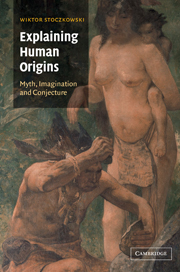Book contents
- Frontmatter
- Contents
- List of tables
- Acknowledgements
- Introduction: in which the author briefly explains his aims
- 1 Prehistory and the conditioned imagination
- 2 Anthropogenesis and science
- 3 In search of causes
- 4 Evolutionary mechanisms: the constraints of nature or of imagination?
- 5 A double game
- Bibliography
- Index
2 - Anthropogenesis and science
- Frontmatter
- Contents
- List of tables
- Acknowledgements
- Introduction: in which the author briefly explains his aims
- 1 Prehistory and the conditioned imagination
- 2 Anthropogenesis and science
- 3 In search of causes
- 4 Evolutionary mechanisms: the constraints of nature or of imagination?
- 5 A double game
- Bibliography
- Index
Summary
THE IMAGINARY ENCOUNTERS THE FACTUAL
L'évolution ne tire pas ses nouveautés du néant. Elle travaille sur ce qui existe déjà, soit qu'elle transforme un système ancien pour lui donner une fonction nouvelle, soit qu'elle combine plusieurs systèmes pour en échafauder un autre plus complexe.
F. Jacob, Bricolage de l'évolutionIn American colleges, one student out of two still recently believed that ‘cavemen’ had to defend themselves against marauding dinosaurs. Prehistorians often deplore the ignorance of the public, and express their surprise that even those who seem interested in the past are prone to accept the most unsound ideas. Yet the struggle of humans against dinosaurs, a very popular image in Europe as well, could be considered not simply as the manifestation of ignorance, but also as a kind of knowledge – one that is erroneous. An erroneous idea does not become less absurd merely for being shared by half the population; it becomes nevertheless interesting as a social phenomenon. In fact, the image of the caveman fighting dinosaurs is not entirely devoid of factual elements: nobody will deny that the dinosaurs really existed, just as prehistoric humans did. On the other hand, the origin of the deep-seated conviction that our ancestors shared the Earth with the dinosaurs remains obscure, because human remains have never been found in the same geological formations as dinosaur bones, and no scholar has risked suggesting that our forebears lived alongside these giant reptiles.
- Type
- Chapter
- Information
- Explaining Human OriginsMyth, Imagination and Conjecture, pp. 29 - 67Publisher: Cambridge University PressPrint publication year: 2002



